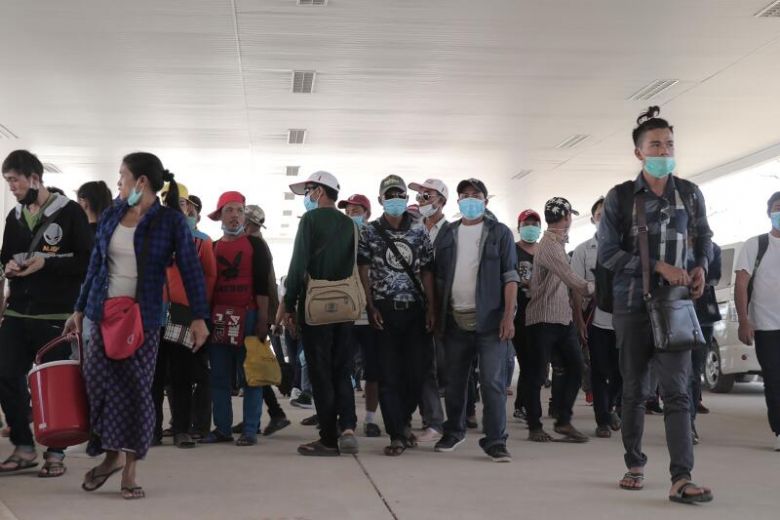
Myanmar nationals with masks at the immigration post in Myawaddy near the Thai border, on March 23, 2020. PHOTO: AFP
SINGAPORE — Tens of thousands of jobless migrant workers from Laos, Myanmar and Cambodia have been scrambling to leave Thailand since shops and retail outlets were shuttered in its major cities to contain the coronavirus outbreak, raising fears of a fresh wave of cross-border infections.
Thailand, which as of Monday (March 23) has registered 721 Covid-19 cases, ordered land border checkpoints closed over the weekend as part of increasingly tougher measures to curb the spread of coronavirus. But the lockdown led to massive queues at Thailand’s busiest overland crossings, with over a thousand workers waiting overnight on Sunday (March 22) before Thai authorities reopened shuttered checkpoints on Monday (March 23) to let them through.
At Thailand’s Sa Kaeo province, close to 40,000 people crossed the border into Cambodia over the weekend. This was twice the usual number, according to the province’s immigration superintendent Arthit Yakaew.
Over the same period, 6,000 workers at Thailand’s Tak province crossed the Mae Sot checkpoint into Myanmar’s Myawaddy town, leaving behind them over 1,000 more workers waiting overnight for an extension of the closure deadline.
“The checkpoint will remain open until 6.30pm today and we will only allow those who were already at the border to cross over,” Tak immigration superintendent Sangkom Tadso told The Straits Times on Monday.
South-east Asia’s second largest economy hosts over three million migrant workers, largely from neighbouring countries.
Wary of the risks posed by swarms of workers returning home before the regional new year celebrations in mid-April, the authorities in Myanmar, Laos, Cambodia and Thailand had already shelved the festivities, or even the public holiday altogether.
But Bangkok’s attempt to contain the outbreak last week by temporarily banning sit-in dining and by shuttering malls and entertainment outlets displaced low-wage Thai and migrant workers,who made a beeline for the interprovincial buses and the border.
“I don’t know when I can come back again. Everything was so sudden,” Ms Orn See, a restaurant worker from Laos, told Thai channel Amarin TV. “If I remain here, I can’t even afford basic things like food. If I go home, at least I have some rice to eat.”
Bangkok Governor Aswin Khwanmuang pleaded with people on Monday (March 23) to stay put and not leave Bangkok.
But with similar shutdowns of public gathering places imposed in Bangkok’s vicinity and other big Thai provinces like Chiang Mai, Khon Kaen, and Nakhon Ratchasima, job options for daily-rated workers have drastically shrunk.
Beyond the Thai border, officials were struggling to screen returnees and arrange their onward journey back to their hometowns.
“The sudden implosion of returnees overwhelmed the measures (that were) in place to screen them,” a Cambodian border official was quoted by the Khmer Times as saying. Cambodia has 86 confirmed coronavirus cases at this point.
While Laos and Myanmar have so far registered zero Covid-19 cases, Myanmar is waiting for the test results of 19 patients with suspicious symptoms. Results on another 187 have turned out negative.
Dr Stephan Paul Jost, the World Health Organization’s representative to Myanmar, told The Straits Times that while a shortage of test kits had initially caused Myanmar to be “a bit conservative” in testing patients, it now has enough material to ramp it up.
“You can’t fight the virus if you don’t know where it is,” he said. “There is spare capacity to test more people even on a daily basis.”